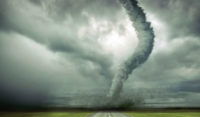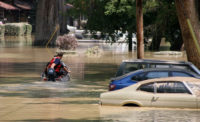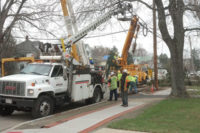Managing Disaster Relief, Notification after Hurricane Sandy

Hurricane Sandy made landfall in New Jersey on October 29, 2012, crashing against the coastline of New Jersey before barreling into New York City and most of the upper East coast.
Costs of the storm are still being tallied as the true damage of the storm is uncovered – flooded subway lines, demolished homes and battered businesses. The thousand-mile-wide storm is responsible for at least 110 deaths across 10 states, including 48 lives lost in New York, along with an additional 65 deaths in the Caribbean.
Eight million homes lost power during the storm, according to reports from The Associated Press. Explosions and downed power lines left lower Manhattan and 90 percent of Long Island in the dark. Four days after the hurricane hit the Northeast, five million of those homes remained without power. A rampaging fire reduced more than 100 houses to mere ashes in Breezy Point, Queens.
According to a press release from Honeywell, more than 6.9 million alerts were delivered through the Honeywell Instant Alert mass notification system to K-12 schools, higher education, municipal, healthcare and corporate customers – the most alerts ever sent for one weather-related event. More than 530 organizations in a dozen states used the system to send details on storm forecasts, states of emergency, road conditions and closures, public transit updates, comfort station locations, pedestrian curfews, power restoration schedules, fuel availability, school and business closings, program cancellations and more to keep people informed and safe. For the two days during the storm, 1.1 million alerts were delivered each day, the release says.
Seventy percent of East Coast oil refineries were shut down due to the storm, but that was not the main problem facing drivers in the Northeast. Power outages closed many gas stations, and those that did still have electricity were soon out of gas as people waited in lines for hours – either on foot or in their vehicles – for the chance to fill up their tanks. According to New York Magazine, a black market for fuel sprang up online, with multiple Craigslist advertisements for $10- or $20-per-gallon gasoline.
Although costs are still mounting, Hurricane Sandy is easily poised to be the second most expensive storm in U.S. history, behind only Hurricane Katrina in 2005, which cost $133.8 billion, according to information from the National Climatic Data Center.
HIS Global Insight reports that $20 billion in property damage from Hurricane Sandy is inevitable, along with an estimated $10 billion to $30 billion in lost business. The New York Stock Exchange was closed for two consecutive days for the first time since 1885, when a blizzard kept the traders away. Flights were shut down across the region and across the world due to the storm, with a combined 21,500 flights cancelled from Monday, Oct. 29, through Wednesday, Oct. 31.
Even organizations with robust continuity plans found themselves scrambling for power, as basement flooding in New York University’s Langone Medical Center cut off its electricity. When the flooding also shut down hospital generators located in the basement, 215 patients were evacuated. Staff had to use flashlights for the evacuation, carrying ill infants and critical patients down flights of stairs to safety. According to Reuters, a recent Joint Commission survey shows that only one-third of hospitals have planned to upgrade their infrastructure, including storm-hardening measures.
The superstorm, which combined with a winter storm over the East Coast, left more than 12 inches of rain in Easton, Md., and 34 inches of snow in Gatlinburg, Tenn.
How would you handle a disaster of Sandy proportions? Read up on our recent coverage of crisis management:
What are Airlines’ Duties of Care to Stranded Hurricane Passengers?
Handling Stress in Crisis Management
Accounting for the Critical Variable in Emergency Response – People
Patch the Roof Before the Storm: How to Prepare for Disaster Recovery
Looking for a reprint of this article?
From high-res PDFs to custom plaques, order your copy today!






